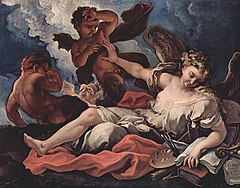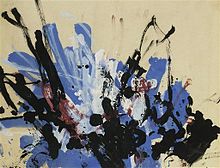Art
![]()
The title of this article is ambiguous. For other meanings, see Art (disambiguation).
The word art (Latin ars, Greek téchne) denotes in the broadest sense any developed activity of human beings based on knowledge, practice, perception, imagination and intuition (healing art, art of free speech). In a narrower sense, it designates results of purposeful human activity that are not clearly defined by functions. According to Tasos Zembylas, the formation process of the concept of art is subject to constant change, unfolding along dynamic discourses, practices and institutional instances.
Art is a human cultural product, the result of a creative process. The work of art usually stands at the end of this process, but can also be the process or procedure itself. Like art as a whole, the work of art itself is characterized by the interaction of content and form. Practitioners of art in the narrower sense are called artists.
The original meaning of the term art, which as a contrast to nature could refer to all products of human labour, has indeed been preserved (as in plastics, for example). However, since the Enlightenment, art has been understood primarily as the expression of the fine arts:
- visual arts with the classical genres of painting and graphic arts, sculpture, architecture and several small forms as well as, since the 19th century, the arts and crafts, commercial art or applied art called borderline area to arts and crafts
- Music with the main divisions of composition and interpretation in vocal and instrumental music. Genres of music (by function or instrumentation).
- Literature with the main genres epic, drama, poetry and essay writing
- performing arts with the main branches theatre, dance and film
Forms of expression and techniques of art have expanded greatly since the beginning of modernity, for example with photography in the visual arts or with the establishment of comics as a link between visual art and the narrativity of literature. In the case of the performing arts, music and literature, forms of expression of the new media such as radio, television, advertising and the Internet can also be added today. The classical classification has been losing importance since the last decades of the 20th century at the latest. Art genres such as installation or the field of media art no longer recognise the basic classical classification.

Sebastiano Ricci: Allegory of the Arts 1690-1694
Requirements and functions
Biology, the sociology of art, psychology, jurisprudence and cultural studies in general are concerned with the question of the biological basis of man's need for art and the psychological, sociological, economic and political functions that art has for man and society.
Biology
The rapid development of the life sciences has led to the fact that higher human cognitive performances are also being studied in the biological disciplines. The artistic need for creation and aesthetic sensations are not exempt from this. Biological investigations with reference to art take place in particular in evolutionary theory and neuroscience.
In evolutionary biology, behaviors are usually explained by a selection advantage. In concrete terms, this means that people who practice and appreciate art would have to produce more offspring than the others. Such an explanatory pattern does not seem immediately plausible in relation to art. Nevertheless, art forms can be found in all historical epochs and cultural areas, which indicates that a need for art is biologically given and not solely a result of social conditioning. Several explanations can be offered for the biological anchoring of the need for art. The most likely is art as a selection criterion for mate choice. Human evolution is characterized by an increase in brain volume and thus in cognitive abilities. The ability to produce art is an externally recognizable indication of creativity, which can also lead to creative solutions in other problem areas. People who had time for art had no problems in satisfying their daily needs for food and security, because whoever has reserves for primarily meaningless activities such as art in addition to everyday life, thus represents his ability to survive. Man as a social being has developed many mechanisms to strengthen his social communities. Art, too, can support human communities as a dispenser of group-specific traditions and values.
Another hypothesis assumes that the need for art is a by-product (epiphenomenon) of the development of other cognitive abilities that are relevant for survival. The advantages of these cognitive abilities would therefore have to exceed the disadvantages of the need for art (time, material).
Confirmation of sociobiological theories by experiments is not feasible, since interbreeding experiments with humans are ethically unacceptable. The theories must therefore remain speculative. In particular, the demarcation from the need for art as a product of cultural evolution is difficult.
Psychology and Neuroscience
In psychology, the creative aspect of art is investigated by creativity research, the perceptual and evaluative aspect by experimental aesthetics.
The value of art is seen, at least in large part, in the expression of feelings.
The evaluation of an artistic work is subject to different factors. For example, characteristics of the evaluating individual (such as his or her personality and tastes) lead to different preferences. A study of over 90,000 individuals showed that personality traits, such as openness to experience, are strong correlates of preferences for certain paintings and for enjoying visits to art galleries.
The evaluation of art across different epochs is neither completely consistent nor completely independent of each other: in the evaluation of the life's work of Renaissance painters by art historians from over 450 years, the degree of agreement between the evaluations is approximately W = 0.5 (possible values: 0 to 1).
It was shown that the spirit of the times as well as objective characteristics of a work that are not subject to the spirit of the times play a role in the evaluation. For example, a study of 15,618 classical music themes examined the importance of objective characteristics and zeitgeist. Both the musical originality of a theme relative to its contemporary works (the Zeitgeist) and its "absolute" originality contributed to the popularity of a theme in similar proportions. Similar results could be shown for linguistic originality.
The neurosciences base their research into the need for art on biological principles. The aim here is to assign artistic creativity to neuronal processes or to different neuronal areas. In addition, there is the enormous heterogeneity of artistic activity. This leads to the fact that different artistic performances can be correlated with different neuronal processes.
Psychoanalysis
Sigmund Freud saw in art - as in any creative activity - a way to sublimate the libido drive in a non-sexual way.
The concept of art in a comprehensive sense
There are the fine arts, but also the art of engineering, the art of speech or diplomacy, the ball artist, and in very many fields the artist in his subject. What, in this broad sense, is common to all art - and what then distinguishes the artists in the respective subjects from one another? Art, in this very broad sense, is a creative activity (and its result) exercised with the highest efficiency; that is, that, measured by the means employed, the greatest possible effect is produced by the result. If the effect is comparable, it is not the greater, but the comparatively more moderate effort that receives the higher esteem as art. This does not mean, however, that the instruments must be simple and modest, or that it is always easy for the artist to arrive at the simplest solution to a problem or at the most effective means of expression.
But the various forms of art differ in the nature of their effect, and this depends on the subject matter. The aim of engineering, for example, is to build a strong and solid bridge; the essence of the essay is perceptive analysis; the emphasis of the fine arts is mainly on arousing and stimulating emotional experiences. One can perform many activities as art in the broadest sense; the criteria for this are creativity and efficiency.
Legal status
Art is a phenomenon in every culture, the object of social conventions and - if a society develops a legal system - an object of legislation. In democratic countries, the right to artistic freedom is either enshrined in the constitution or guaranteed within the framework of freedom of expression. In states with a different political organization, the practice of art is often regulated and/or instrumentalized for propaganda purposes. Dictatorships often use art specifically to stabilize the respective regime. Free artistic expression is subjected to censorship and threatened with repression, or actually exposed to it. Due to such repression, artists then do not produce critical works (scissors in the head), do not publish them, or go into an inner emigration. Some artists internalize the state, social and/or religious requirements and produce - out of conviction or economic constraints - affirmative works.
Plagiarism, imitations and works strongly influenced by other artists have existed and continue to exist in every phase of art history. If the producer conceals his originals, this is just as punishable as an art forgery as an infringement of copyright. In order to make such an infringement legally tangible, the legislator introduces criteria that play no role in the art business itself. From the point of view of copyright law, for example, an artist can only call a work his own when it has reached a sufficient level of creation. This presupposes a personal, individual and intellectual (human) creation which has a form perceptible through the human senses (see the concept of work in copyright law with regard to the level of creation).
In Germany, artistic freedom is a fundamental right protected by Article 5 (3) of the Basic Law. Works of art themselves can, on the one hand, enjoy legal protection as cultural assets through national and international regulations and organisations (UNESCO, Blue Shield, etc.) and, on the other hand, be subject to legal restrictions (export bans, etc.).

A picture of the chimpanzee Congo
See also
![]()
Portal: Arts and culture - Overview of Wikipedia content on the topic Arts and culture
![]()
Portal: Visual arts - Overview of Wikipedia content related to the topic Visual arts
Questions and Answers
Q: What is art?
A: Art is a creative activity that expresses imaginative or technical skill and produces a product or an object.
Q: What are the different types of art forms?
A: The different types of art forms include visual arts, performing arts, poetry, prose, music, and theatre.
Q: What is the product of art called?
A: The product of art is called a work of art.
Q: What is a craft?
A: A craft is a kind of art that is useful in a practical sense, such as a sculptured clay bowl that can be used.
Q: Who are the people who make art called?
A: The people who make art are called artists.
Q: What do artists hope to achieve through their art?
A: Artists hope to affect the emotions of people who experience their art.
Q: Why do some people make art?
A: Some people are driven to make art due to their inner creativity.
Search within the encyclopedia